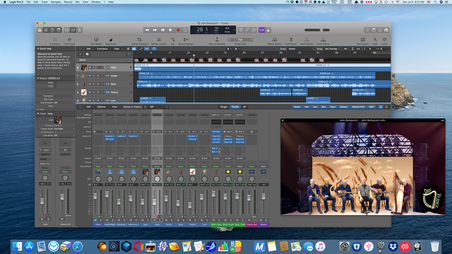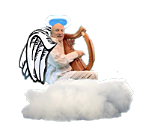I make the videos at home. It's fun to create all the pieces and then put them together to make Dan and the Dannettes and the Danster Quartet Minus One (with various additions and deletions) come to life. The hardest part for me is folding up the green screen after shooting the videos it's a 9' x 15' monster - all by myself when I am cleaning up afterwards, though I have worked out a routine that makes it not too difficult. And since I moved it to its own room I don't have to do that any more. And all the rest is fun.
|
Here's a video about how I make FunnyHarp videos.
|
| Note: the video is a little more up to date than this page, but the process is the same. Also when I made the video my YouTube channel was DanHarpMusic, but in order to turn it into an official Artist's Channel I had to change the name to "Dan Veaner". |
The next step is to record it. I use a Tascam Pocketstudio with various pickups and mics to record the harp and some other instruments, mainly because my computer is upstairs and the harp, which lives downstairs with the other instruments, is kind of heavy. Lately I have been recording smaller instruments (guitar and smaller) upstairs because I can get a better sound quality using the mics there.
I start by choosing or writing a song and try to picture fun ways to present it.
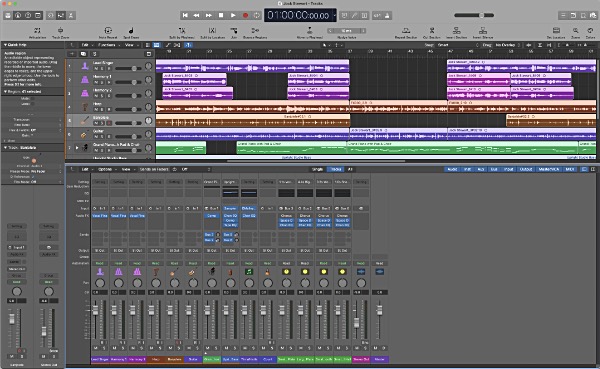
I record most of the vocals, any midi tracks, and some (small) instruments using Logic Pro, and edit the tracks into what I hope will be a final mix.
Once I have a workable sound track I use an iPhone to record each video clip, generally in front of a green screen, at least one for each version of me that will appear in the video. I use a blue screen for a couple of the videos that have something green in them, like the hats in "Early One Morning" and the frogs in "Amphibian Blues" (not named for the screen). I've had the blue screen for years since my family made puppet videos while our kids were growing up. A lot of the puppets were frogs -- they would have disappeared if we had used a green screen. Of course it wouldn't have mattered for the stand-up chicken comic who only tells chicken jokes.
I push all the furniture aside in a room in our house, and set up the screen. I make a version of the sound track with about 15 seconds of lead time and then a count, giving me time to get into position and start the recording. I crank the sound through a practice amp fairly loudly so it will be easy to hear on the video clips.
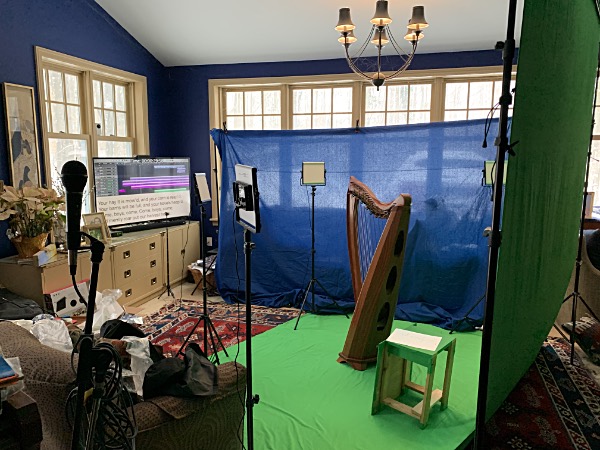 I'll bet they don't have this problem in Hollywood. I have to use my blue screen to block out sunlight from the windows (except when I am recording something green (then I have to flip the screens). I record a teleprompter video that I airplay to the TV. |
I also learned that because of the size of the room and the camera angle, using a real chair made the perspective go out of whack - it looked like the chair was tipped up or floating in air. So I made a green stool, and I now use pictures of stools and chairs in the final video with the right perspective that makes sense for the scenes. It is also handy for making it appear I am sitting on a step or something else in the pictures I use for backgrounds, like the bass player in "Mama Don't Allow".Any props or wardrobe changes are draped on a chair, out of view. And I have to admit that I don' use fancy lighting (even though I am trained in stage scenery and lighting design). That little tiny camera in the iPhone produces a clear picture and seems to make low light into good light. But I was getting too many artifacts when chromakeying out the green. So I got some LED photography lights that realy work well. You can adjust the color temperature as well as the brightness, handy for lighting the green screen differently from a human being. Final Cut Pro (FCP) video editing software also has some lighting effects, which I sometimes use.
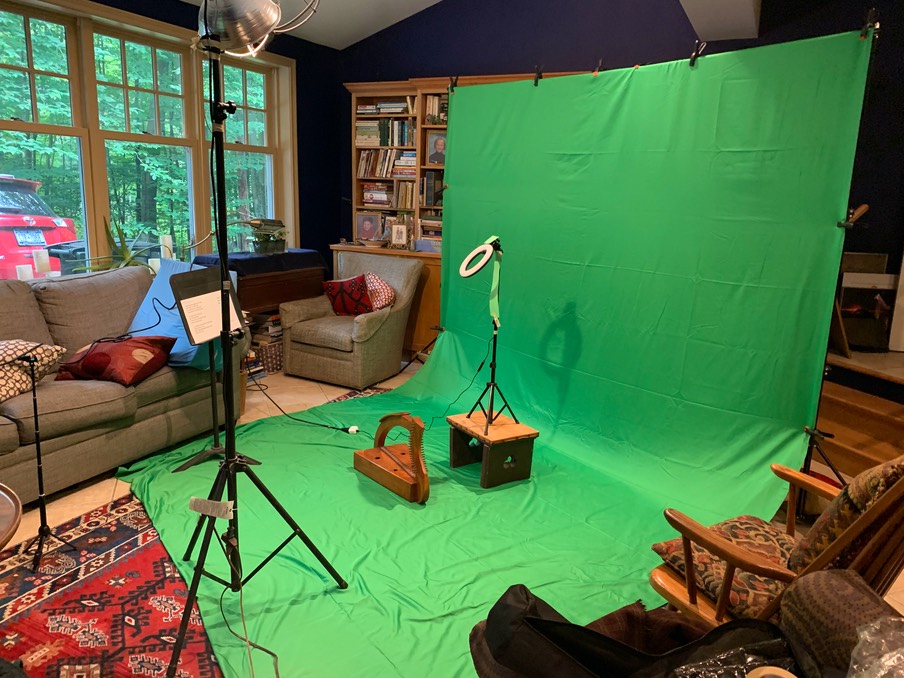
I did have a lighting problem one day, though. My wife's car was parked outside the window, and when the sun reached the optimum spot, if reflected off her rear car window onto the green screen, making bright spots and dark shadows that would ruin the effect. I doubt that moving a car for the purposes of lighting is something on a Hollywood studio's checklist, but it is certainly on mine!
Because I already have a decent sound track, I lip sync for the singing and finger sync for the instruments. Please don't look too closely -- sometimes I am so busy trying to remember what I did in the sound recording that I forget to move my mouth!
Now I import the soundtrack and the individual video clips into Final Cut Pro. Here's where playing that loud soundtrack comes in handy. As I import each video clip I play it along with the real sound track until the notes and words match up between the two. When it sounds like one sound track with no lags between same notes on different tracks, I know the lip and finger-synching will work, so it looks like I am really singing and playing on the final video.

FCP has a lot of titles to choose from, but I sometimes make my own fancy custom ones in Motion, which very nicely imports my titles into FCP. I use various masks and effects in FCP, and also the motion, like the angels in Celestial Employment or the boat being pulled by a lawnmower in Larry, Curley, and Mowing. FCP does the Chromakeying, turning the green screen into whatever setting I need, and I add other graphics like the island and the palm tree in Moonlight Bay, or the stage in John Barleycorn. I try to use pictures I own, but sometimes use other graphics and videos, such as the wonderful stock videos from Pexels.
Because of the green screen chromakeying process I can't wear any green costume pieces, because they become invisible when the chromakey is applied. So I cheat. FCP has the ability to change colors in all or part of a clip. For me this works best with blue clothing. Once the chromakey has been applied I can turn the blues into greens (or reds, or purples, etc,). So when it looks like I am wearing several different colors of the same design on a shirt, it is likely it is one blue shirt that I have changed the color on digitally for each Dan.
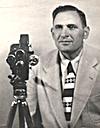 I have to say that when my grandfather Oscar Horovitz (right) taught me how to edit 16mm film using a splicer (which was a little device you used to literally glue film clips together) we never dreamed that some day you could not only edit clips, but enhance them so much with effects and titles. He won over 100 awards world-wide for his amateur films, and he taught me a lot about composition and editing. He made his titles on cards, and he had a special metal rig - it was a big thing in his basement - on which he could mount the title cards and a camera to film them (back when 'filming' literally meant using movie film, and wasn't just another way to say "recording motion pictures"). He would have loved FCP and I think of him every time I use it.
I have to say that when my grandfather Oscar Horovitz (right) taught me how to edit 16mm film using a splicer (which was a little device you used to literally glue film clips together) we never dreamed that some day you could not only edit clips, but enhance them so much with effects and titles. He won over 100 awards world-wide for his amateur films, and he taught me a lot about composition and editing. He made his titles on cards, and he had a special metal rig - it was a big thing in his basement - on which he could mount the title cards and a camera to film them (back when 'filming' literally meant using movie film, and wasn't just another way to say "recording motion pictures"). He would have loved FCP and I think of him every time I use it.
Once I have exported my video I check it -- oftentimes I need to fix something in the visuals, or some terrible sound becomes more apparent in the put-together video than it did in the editing software.e I have exported my video I check it -- oftentimes I need to fix something in the visuals, or some terrible sound becomes more apparent in the put-together video than it did in the editing software.
